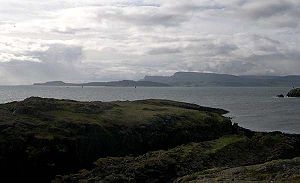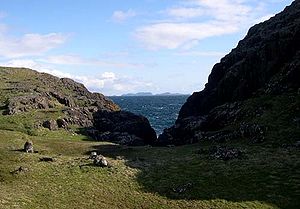
Fladda-chùain
Encyclopedia


Trotternish
Trotternish or Tròndairnis is the northernmost peninsula of the Isle of Skye, in Scotland.One of its more well-known features is the Trotternish landslip, a massive landslide that runs almost the full length of the peninsula, some...
peninsula, Skye
Skye
Skye or the Isle of Skye is the largest and most northerly island in the Inner Hebrides of Scotland. The island's peninsulas radiate out from a mountainous centre dominated by the Cuillin hills...
.
Name
The name of the island derives from Old NorseOld Norse
Old Norse is a North Germanic language that was spoken by inhabitants of Scandinavia and inhabitants of their overseas settlements during the Viking Age, until about 1300....
Flatey, meaning a "flat island", and Cuan, a Scottish Gaelic word meaning "ocean" (or bay
Bay
A bay is an area of water mostly surrounded by land. Bays generally have calmer waters than the surrounding sea, due to the surrounding land blocking some waves and often reducing winds. Bays also exist as an inlet in a lake or pond. A large bay may be called a gulf, a sea, a sound, or a bight...
in Irish
Irish language
Irish , also known as Irish Gaelic, is a Goidelic language of the Indo-European language family, originating in Ireland and historically spoken by the Irish people. Irish is now spoken as a first language by a minority of Irish people, as well as being a second language of a larger proportion of...
and Old Gaelic). The latter probably refers to the Minch
The Minch
The Minch , also called The North Minch, is a strait in north-west Scotland, separating the north-west Highlands, and the northern Inner Hebrides, from Lewis and Harris in the Outer Hebrides...
, which is known as An Cuan Sgìth ("Ocean of Skye") or Cuan na Hearadh ("Ocean of Harris"). The suffix is also added to distinguish this island from the many others with similar names.
History
Fladda-chuain is the subject of some legends.There are the ruins of a chapel here, said to have been founded one "O' Gorgon" in the days of St. Columba
Columba
Saint Columba —also known as Colum Cille , Colm Cille , Calum Cille and Kolban or Kolbjørn —was a Gaelic Irish missionary monk who propagated Christianity among the Picts during the Early Medieval Period...
, and/or dedicated to him. It is said also that MacDonald of the Isles hid his deeds here prior to the Jacobite rising
Jacobite rising
The Jacobite Risings were a series of uprisings, rebellions, and wars in Great Britain and Ireland occurring between 1688 and 1746. The uprisings were aimed at returning James VII of Scotland and II of England, and later his descendants of the House of Stuart, to the throne after he was deposed by...
of 1715.
The last known inhabitant was known as "Am Muileach Mòr", which means either "the Big Mull
Isle of Mull
The Isle of Mull or simply Mull is the second largest island of the Inner Hebrides, off the west coast of Scotland in the council area of Argyll and Bute....
man", or the "man of the headland".
In 2002 the nuclear submarine HMS Trafalgar
HMS Trafalgar (S107)
HMS Trafalgar is a decommissioned of the Royal Navy. Unlike the rest of the Trafalgar-class boats that followed, she was not launched with a pump jet propulsion system, but with a conventional 7-bladed propeller...
grounded on Fladda-chuain whilst travelling at 14.7 knots (28.8 km/h) during a traverse of the Fladda-chuain-Eilean Trodday
Eilean Trodday
Eilean Trodday is an island in The Minch just off the north coast of the Trotternish peninsula of Skye in Scotland.Eilean Trodday is about in extent and the coastline has various caves and stacks. The island was inhabited in the past and there are the ruins of a small chapel, which may have been...
trough, resulting in some damage to the submarine and three minor injures to the crew. After the grounding the submarine re-surfaced and proceeded to the Faslane
HMNB Clyde
Her Majesty's Naval Base Clyde is one of three operating bases in the United Kingdom for the Royal Navy...
base by surface transit. The main cause of the accident was reported as being the use of tracing paper to cover the navigational chart to protect it from being written on, so obscuring vital information. Damage to the hull cost an estimated £5 million to repair.

